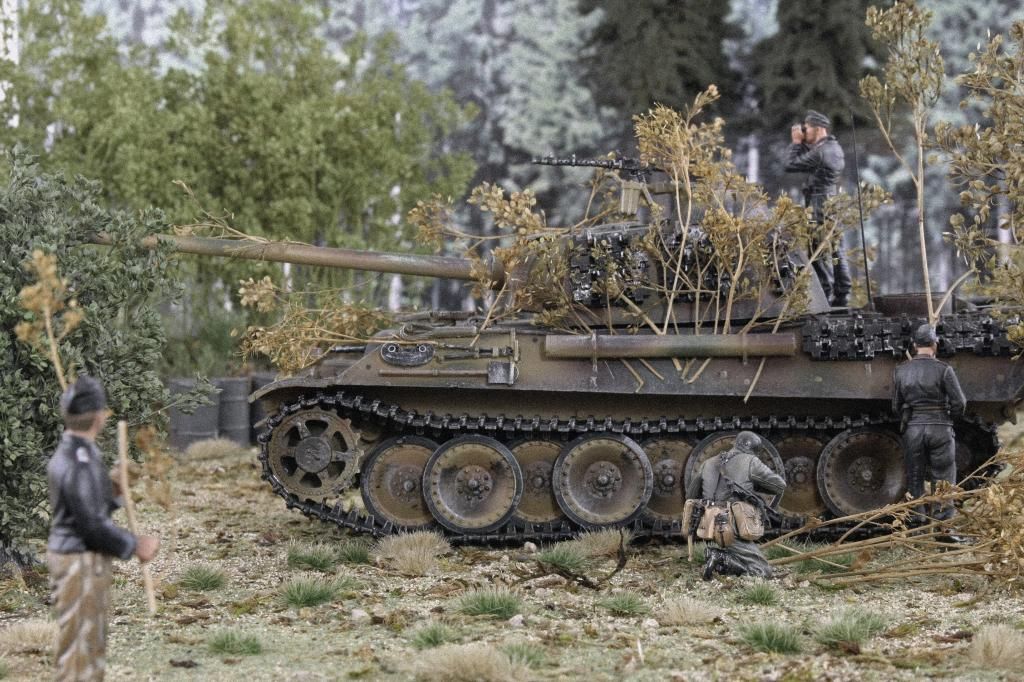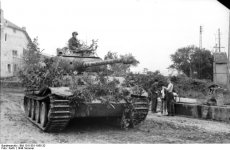fmethorst
Command Sergeant Major
- Joined
- Feb 18, 2008
- Messages
- 2,492
This has been an interesting discussion. Thanks to all for their reviews and excellent pictures
Some notes regarding the camouflage on late model Panthers.
The transition from field applied camouflage to factory applied camouflage began in August 1944.
On August 19 1944, a general order was sent to all assembly plants involved in the Panther program which stated "All Panthers were to be painted with a standardized camouflage pattern prior to being shipped from the assembly plants"
The factory schemes are recognizable from the field applied schemes by their more balanced application of RAL7028, 6003, 8017, more consistent patterns and hard edges between colors (less feathering between colors). It should also be noted that later in the war the base coat was changed from RAL7028 dark yellow to RAL 6003 olive green and even bare primer as paint stocks dried up.
The use of the Ambush (aka "Licht und Schatten") pattern, which is usually defined as a standard factory scheme plus additional dots of contrasting colors overlaid on the base scheme, only occurred briefly at one assembly plant (Daimler-Benz) and was discontinued in late September. M.A.N. used another technique referred to as "Disc-Camouflage" which utilized a stencil made up of different sized discs connected at the edges. This resulted in irregular sized and shaped pattern being overlaid on the based scheme. This resulted in a pattern similar to Ambush but with the dots replaced by irregular shapes.
Based on this information, Figarti's Panther most closely matches a Daimler-Benz Panther produced in September 1944. The model does not feature hard edges between colors which is inconsistent with factory schemes. There should also be more contrast between RAL8017 (brown), the darker color, and RAL6003 (green) the medium color. Like others I'm not a fan of the silver.
A few examples of factory paint schemes




Frank
Some notes regarding the camouflage on late model Panthers.
The transition from field applied camouflage to factory applied camouflage began in August 1944.
On August 19 1944, a general order was sent to all assembly plants involved in the Panther program which stated "All Panthers were to be painted with a standardized camouflage pattern prior to being shipped from the assembly plants"
The factory schemes are recognizable from the field applied schemes by their more balanced application of RAL7028, 6003, 8017, more consistent patterns and hard edges between colors (less feathering between colors). It should also be noted that later in the war the base coat was changed from RAL7028 dark yellow to RAL 6003 olive green and even bare primer as paint stocks dried up.
The use of the Ambush (aka "Licht und Schatten") pattern, which is usually defined as a standard factory scheme plus additional dots of contrasting colors overlaid on the base scheme, only occurred briefly at one assembly plant (Daimler-Benz) and was discontinued in late September. M.A.N. used another technique referred to as "Disc-Camouflage" which utilized a stencil made up of different sized discs connected at the edges. This resulted in irregular sized and shaped pattern being overlaid on the based scheme. This resulted in a pattern similar to Ambush but with the dots replaced by irregular shapes.
Based on this information, Figarti's Panther most closely matches a Daimler-Benz Panther produced in September 1944. The model does not feature hard edges between colors which is inconsistent with factory schemes. There should also be more contrast between RAL8017 (brown), the darker color, and RAL6003 (green) the medium color. Like others I'm not a fan of the silver.
A few examples of factory paint schemes




Frank





